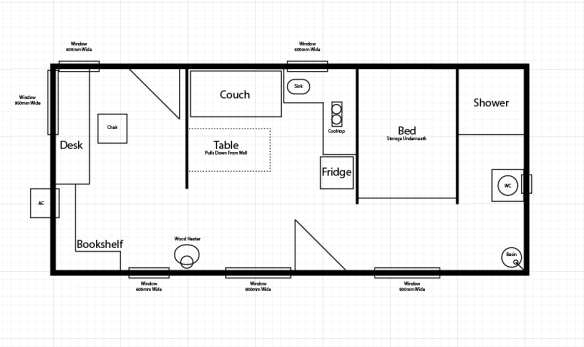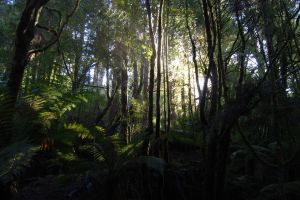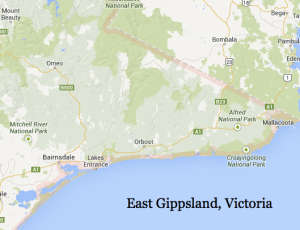A couple of days ago I wrote a post detailing my Real World – current – cost of living. The costs totaled $33,000 per year. Many would think that is not much at all. Considering my salary is roughly double that it allows me to save a substantial amount of money. However, it’s not where I want to be financially. To earn that money requires sacrifice. Namely, my freedom. I work upwards of 70 hours a week (not including preparation, commuting, winding down, de-stressing time, etc) in a 9-5 white collar office job and managing my own small business part-time. Much of my leisure time is spent stressing or thinking about work. I find it hard to remove myself. And for what? Some money? I’d much prefer to earn, say, $10,000 per year, live deliberately, and have endless amounts of time to do what I enjoy. To wake up naturally, go to bed when I am tired, take long walks and not worry about what productive things I could be doing instead, lay on ground and watch the clouds drift by, read all the books I have always wanted to read, potter in the garden when I feel like it. To enjoy life.
“Live on $10k? That’s impossible!” I hear you insist. Well, in my current state, yes it is. My relatively simple life costs well in excess of that. And it is for exactly this reason I wish to simplifier my life even further. I pay $7,000 in rent each year alone. To earn that amount requires me to sacrifice a substantial amount of time with which I’d prefer to be doing something else. To live on $10k would require much less sacrifice. Think about it. How many hours of work would it take to earn that? My calculations, based on a job that earns $25/hour, less than 8 hours per week. That’s a day of work per week. But how can I live on so little money. Well, let me share with you my plans for my Desirable World.
Before I would I’d like to state that what I write below isn’t meant to be instructional or certain. Many of the ideas I propose will seem and may be nonviable. As I am so early in the process I have a lot to learn. Consider them foundational positions on which I will expand. Most are conditional – they depend on certain things being true in order to be viable. For instance, pumping water from a stream will only be viable if I buy a block that has a stream that I can access. For now, it’s really just one big brain fart. It’s the possibilities that may become potentialities that I am thinking about, researching further and am using as a starting point on which to plan my Desired World.
Rent / Housing
When I first started piecing together my Desired World I toyed up with a number of housing options;
– Permanent caravan and annex in a holiday park;
– Caravan on a block of owned / rented land;
– Cheap doer-uperer house in Zeehan or Queenstown, Tasmania; or
– Tiny house on owned / rented land.
Each is with its pros-and-cons. The holiday park idea for instance; it can be quite cheap – some caravan parks in Australia have permanent sites available for as little as $1,000 per year – but doesn’t offer much in the way of security. I have heard many stories of permanent residents being uprooted due to parks closing or being redeveloped. Plus, you never know who you are going to get as a neighbour – a bother when you live so close to them. Even a cheap house in a struggling town, like Zeehan, is up towards the $100,000 figure. That is too expensive and doesn’t provide me exactly what I want – I’d prefer not to live in a town. I really don’t want to take out a mortgage. That will just leave to more wage slavery and anxiety. I’d prefer to buy outright. Hence, I need an affordable option.
I’ve decided that a caravan / tiny house on a block is what I want. Surprisingly, there are decent blocks of land in Australia for as little as $10,000. The sort of land I am looking for is more in the $20-$30k territory. That would get me 1/2-1 acre in a pretty rural area, within 20km of a town. As I don’t drive, I need for there to be a town that has some sort of shop and public transport connections. I will cycle to town when need be. Initially I wish to live in a caravan and build a small shed to the side – with a shower with a view and composting toilet and small laundry / storage shed.
When the time is right – and depending on the council’s view on caravans as dwellings – I will build my dream tiny house. The house I have in mind is 6×3 metres, on poles or a concrete slab (the former is easier, the latter is better from a passive solar point-of-view – something I have come to appreciate living in a drafty old house). It has a wooden stud frame, cedar cladding and plenty of windows, placed where they should be. Out the front is a small deck with a cob oven to the side, overlooking my land where I will plant a small orchid and a vegetable garden.
As the figures in this budget are meant to reflect my monthly variable costs I won’t go into much detail about how much it might cost buying and refurbishing a caravan, building a shed, building the tiny house and so on. This will all comes from my initial savings. As for the purchase of land, my ability to reach my savings goals and the health of my business will determine whether I buy it outright or take out a small mortgage. I prefer the former. Council rates for the sort of land I am looking for will be around $500 per year. For the sake of this budget, let’s assume I did take out a small mortgage for the land at an interest rate of 4.95%.
Cost: $216 per month.
Food
My aim is to become as self-sufficient as possible with food. I intend to grow a large vegetable garden, tend a small fruit and nut tree orchid and keep chickens for their eggs. I will garden following permaculture principles to ensure the land is used sustainably and to limit the need for external inputs. I want to work with the environment, not against it.
The few people that I have spoken to about this mentioned that food in rural areas is much more expensive. This is true, especially if you’re shopping at small-town IGAs and FoodWorks supermarkets. However, my intention is to buy as little as possible from supermarkets. I wish to move away from processed foods and instead will buy in bulk and will cook everything from scratch. I will also preserve excess fruit and vegetables that I grow or may buy on special.
I’ve been rather generous with how much I have budgeted for food and expect it to cost much less when my garden is established.
Cost: $200 per month.
Water
Water is the trickiest of the “utilities” to off-grid. Energy you can be quite certain of and waste management is straight-forward to keep within the property. Water is dependent on so many hard-to-predict variables. The off-grid options include: rainwater catchment, drilling a bore or pumping from a stream. Bore drilling is probably the most certain of these three options, but expensive. Relying on the rain water in Australia is risky. However, most of the regions I am looking at have decent rainfall. It is for this reason I intend to experiment with rainwater catchment and explore bore drilling later on only if necessary.
I enjoy being austere and for that reason I will try to limit my water consumption. And my grey water system will certain factor into the effective use of water on the property. According to the Australian Government, Australian’s use on average 350 litres each of water per day [1]. Of that, only about 1% is for drinking. The rest is for bathing, washing, cooking, flushing the toilet, and other wasteful endeavors. Most of which is then swept out to sea. My aim is to use a fraction of that. I haven’t set any numbers but I will purchase a large rainwater tank and will ensure there is a sufficiently large catchment area feeding into it – the shed roof, the house and perhaps some freestanding structures for that purpose solely. I also intend to have recycled food-grade water drums sprinkled around the place capturing water for use on the gardens.
Cost: Nil.
Electricity
In my novice opinion, off-grid electricity is the easiest of utilities to install and generate. One can pop down to any electronics (Jaycar, Dick Smith, etc) or camping store (Ray’s, Anaconda, etc) and buy a small solar system with inverter and plug in their phone charger and start generating their own energy. Designing a system that can support a house is obviously a little more complex.
Australia is blessed with sun. That’s why solar is such an obvious option for energy production in this country. During summer in the SE corner of Australia, 6-8 hours of good sun light is the norm. Even winter, in many parts, good solar access can be almost guaranteed. I intend to produce the majority of my energy via solar, with a diesel generator for backup.
Using a number of 180W panels and a battery bank I will be able to produce around 5kWh of electricity per day. My usage will probably be around half of that. The only things I intend to have plugged in are a couple of 12V lights – with LED globes – my laptop charger, a small fridge and maybe a chest freezer. Things like air conditioning and a caravan-style twin-tub washing machine can be run off the generator. The only variable electricity cost I will have is some diesel when I have to resort to using the generator.
Cost: $10 per month
Gas
My cooktop will be a two-ring cast iron camping stove. I love the simplicity of thse and, if I am honest, I think they look great. This will be plumbed into a 9KG gas bottle that lives outside. I will have a second 9KG gas bottle connected to a BBQ which will also be used for cooking. When the house is built – or maybe before, if I feel inclined to bake – I will build a cob pizza oven which will run on a wood fire. I expect two gas bottles will last approximately one month.
Cost: $45 per month.
Internet
A lot of punters argue that one can not be off-grid and have the internet. By definition, this is true. However, I believe the internet provides a greater good. It’s environmentally sensible to generate your own energy – especially if you live in whoop-whoop – and manage your own waste. So these are obvious things to off-grid – plus connecting to the grid in rural areas can be expensive. The internet will allow me to earn money from home – by allowing me to continue to run my business – and is a valuable knowledge and entertainment tool.
I’d like to say that rural Australia is hard done by when it comes to broadband but I don’t believe this is entirely true. The NBN is on its way and, for a lot of rural users, is already available through interim satellite services – for many, this is as good as it will get. Then there is ADSL2+ in many rural exchanges, 3G wireless, and fixed wireless like WiMAX. From what I have read about broadband in rural United States, we’re in a pretty good position by comparison.
Satellite will be my only option in the sort of places I want to live. At the moment, under the NBN, one can have a satellite connection installed at no cost. To be sure, the monthly fee is much higher than with ADSL but cheaper than mobile wireless. Several providers offer a 30-60GB satellite plan for $60 – this would suit me fine. Whereas the highest wireless plan is around 15GB for a whopping $95 per month. Wireless can also be problematic from a performance point-of-view, especially in hilly, treed areas.
Cost: $60 per month.
Phone
I don’t need a landline. Haven’t used one – nor VoIP – for many years. I will opt for a pre-paid Telstra mobile. This will be mostly used for business purposes and when I am away from the house. I expect that Skype and email will be my main forms of communication at the house. I expect even Telstra coverage will be patchy there.
Cost: $30 per month.
Entertainment
My idea of entertainment has already changed significantly from what it was 5 years ago. Back then, shopping, dining out, drinking at pubs, clubbing and other costly activities were my idea of a good time. Perhaps I have grown up. Perhaps I have become boring.
Nowadays I find great enjoyment in tending to a garden, going for walks or hikes, cycling, reading books or blogs, writing and, sometimes, just sitting in silence with my thoughts. If I am completely honest, many of these activities are made better with a glass of red wine.
I expect that my entertainment costs will be next to nothing in my Desired World. Perhaps something to eat or a drink out when I am in town or in the city once a month or so?
Cost: $50 per month.
Medical
Much like at present, I don’t see my medical expenses changing. Touch wood.
Cost: $5 per month.
Booze
Back to the cask wine I say. Don’t judge me!
Cost: $20 per month.
Transportation
As I mentioned above, I don’t drive. Transport costs will therefore be higher than they are now as I rely on limited – and expensive – public transport. The places I am looking at are near towns that have public transport connections. I only expect to use public transport once a month. The rest of my commuting will be done by push bike. And maybe I will be lucky enough to arrange for a neighbour to taxi me into town on their trip sometimes?
Cost: $50 per month.
Holidays
I have made a pact with myself. If this all works out and I have as much disposable income as I have budgeted, I will make an annual trip to NZ – love the place. I will probably do this over the hottest part of the Australian summer – I really don’t like the heat. When I travel to NZ I backpack – I stay in hostels, catch coaches, hitchhike, and spend most of my time in the wilderness rather than in tourist towns. I have done this trip many times and have a good idea of what it will cost.
Cost: $1,500 per year.
—
So there you have it. The budget that I intend to live on in my Desired World. A grand total of $8,232 excluding holidays. Let me ask you. Does any of that seem particularly austere? I don’t think so. The way I look at it is I will be connecting with reality again. I will be working for what I need rather than to further someone else’s end. I will being going back to our roots – shelter and food. With those things ticked off, I can pursue the things I enjoy without feeling guilty about not doing something I am made to believe I should be doing.
Well, that’s what I think.
[1] http://www.naa.gov.au/Images/sunburnt_tcm16-36815.pdf










